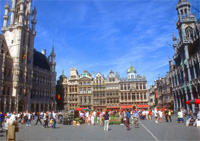Whether you are fascinated by medieval times or enjoy the shiny and new, Brussels will seem personally built for you. It is divided into two main areas. Lower Town looks like a village taken straight out of the medieval times. Cobblestone streets act like veins leading to the major organs of the city. Ilôt Sacré is the city's heart. Arching, gothic and jaw-droppingly spectacular, Ilôt Sacré is an old commune now turned into a glorious tourist attraction for anyone with any passing interest in unforgettable architecture. Slightly south of the heart is the Cathédrale des Sts Michel & Gudule, a magnificent twin-towered cathedral that blends Romanesque, gothic and renaissance architecture in honor of Brussels's male and female patron saints.
Grand Place is a 12th century square that transports its visitors into the past. It has charming shops and marvelous restaurants serving Brussels's famous beers and delicacies. Originally the square housed jousting tournaments, public executions and town meetings. Now, with its row after row of shops and beautiful Hôtel de Ville gothic castle hotel, Grand Place is, according to LonelyPlanet.com, 'the hub of commercial, political and civic life in Brussels.' LonelyPlanet.com also says, 'The Grand Place radiates different auras depending on the time of day and season. In the morning, superb guildhouses at the bottom (southern) end glint in the sun; at dusk, the azure sky becomes a vivid backdrop to the illuminated buildings. During the summer a carpet of flowers covers the whole square, and in winter ice-skaters swirl across the transformed cobbled surface.'
On the opposite side of the city is Upper Town, a striking contrast to the medieval atmosphere just described. Upper Town is home to Brussels's elite and houses chic shopping districts, monstrous modern museums, towering structures of glass and steel, the parliament building, the Domaine Royale, which is the residence of the royal family and much more. It is striking to stand on one side of the city and stare at the other. It is like looking through a time warp.
Brussels is not only the capital of Belgium, but it is the capital of the European Union as well. It is behind only New York as the city with the largest number of international organizations and corporations in the world, making it the center for governmental administration, banking and insurance industries in Europe.
While French and Dutch are Brussels's official languages, German and English are often heard, as are a large number of other European languages. Since it is the center of the European Union, it plays host to a large number of Europeans from all over the continent, making it a fascinating place to explore for anyone interested in foreign relations, foreign languages, diplomacy or politics. It is like the Washington D.C. of Europe.
While watching European politics take place in the city can delight all year round, the main event of Brussels occurs every summer in the center of Grand Place. It is called Ommegang, and the entire population comes out to celebrate it. As with Christmas back in the states, Ommegang began as a religious celebration but has lost almost all religious meaning in exchange for music, parties, parades and plenty of fun games and activities. It has become a celebration of life, and people come from all over the world to participate in the exciting events.
Americans often regard Belgium as not being a culturally important European country. That is unfortunate and incorrect, because Belgium offers some of the most intriguing cultural opportunities of any country in Europe. As the capital of Belgium, Brussels is at the core of much of this culture. It is the center for European politics. This fact, coupled with its stunning architecture, food, and beer, make it a fascinating place to study, visit or live.


